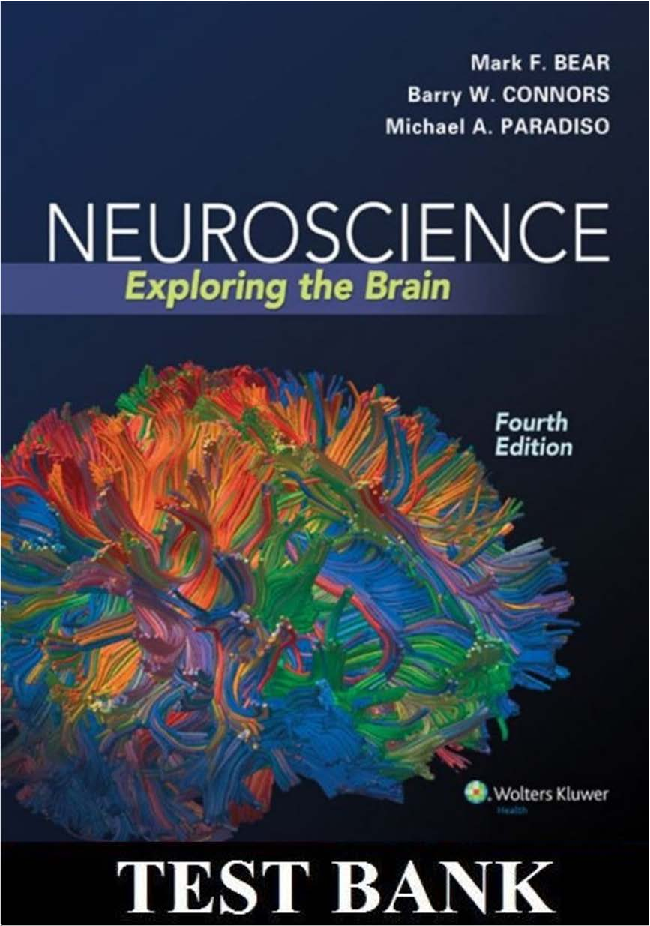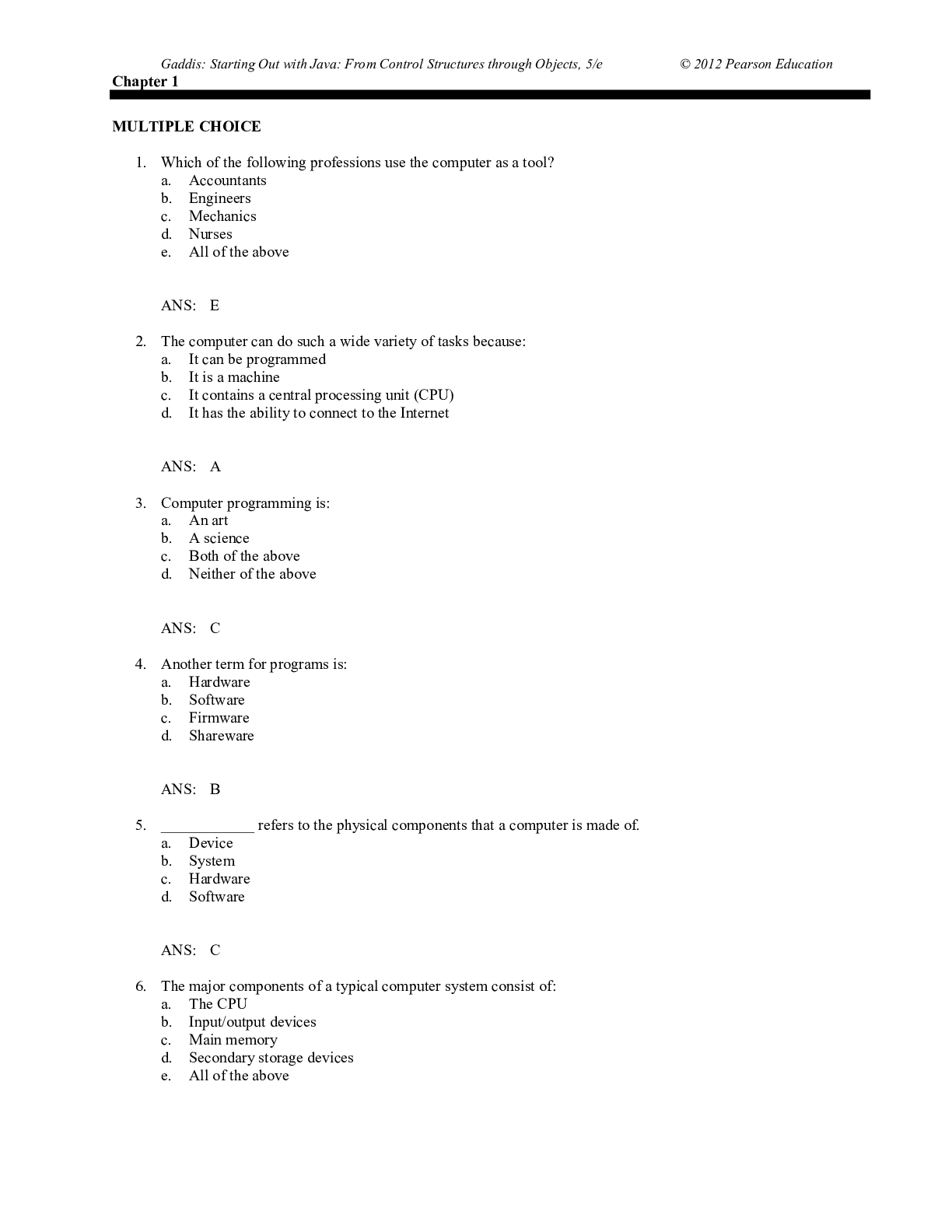*NURSING > TEST BANKS > Test bank for Principles of Pediatric Nursing: Caring for Children, 7th Edition by London; Ladewig; (All)
Test bank for Principles of Pediatric Nursing: Caring for Children, 7th Edition by London; Ladewig; Davidson; SHAW; Bindler; Cowen
Document Content and Description Below
1) Which nursing role is not directly involved when providing family-centered approach to the pediatric population? 1. Advocacy 2. Case management 3. Patient education 4. Researcher Answer: 4 E... xplanation: 1. A researcher is not involved in the family-centered approach to patient care of children and their families. Advocacy, case management, and patient education are all roles directly involved in the care of children and their families. 2. A researcher is not involved in the family-centered approach to patient care of children and their families. Advocacy, case management, and patient education are all roles directly involved in the care of children and their families. 3. A researcher is not involved in the family-centered approach to patient care of children and their families. Advocacy, case management, and patient education are all roles directly involved in the care of children and their families. 4. A researcher is not involved in the family-centered approach to patient care of children and their families. Advocacy, case management, and patient education are all roles directly involved in the care of children and their families. Page Ref: 4 Cognitive Level: Analyzing Client Need &Sub: Safe and Effective Care Environment: Management of Care Standards: QSEN Competencies: Patient-centered care | AACN Essential Competencies: Essential II: Basic organizational and systems leadership for quality care and patient safety | NLN Competencies: Professional identity | Nursing/Integrated Concepts: Nursing Process: Assessment/Coordination of care Learning Outcome: LO 1.2 Compare the roles of nurses in child healthcare. MNL LO: Family-centered care 2) A nurse is working with pediatric clients in a research facility. The nurse recognizes that federal guidelines are in place that delineate which pediatrics clients must give assent for participation in research trials. Based upon the client's age, the nurse would seek assent from which children? Select all that apply. 1. The precocious 4-year-old commencing as a cystic fibrosis research-study participant. 2. The 7-year-old leukemia client electing to receive a newly developed medication, now being researched. 3. The 10-year-old commencing in an investigative study for clients with precocious puberty. 4. The 13-year-old client commencing participation in a research program for Attention Deficit Hyperactivity Disorder (ADHD) treatments. Answer: 2, 3, 4 Explanation: 1. Federal guidelines mandate that research participants 7 years old and older must receive developmentally appropriate information about healthcare procedures and treatments and give assent. 2. Federal guidelines mandate that research participants 7 years old and older must receive developmentally appropriate information about healthcare procedures and treatments and give assent. 3. Federal guidelines mandate that research participants 7 years old and older must receive developmentally appropriate information about healthcare procedures and treatments and give assent. 4. Federal guidelines mandate that research participants 7 years old and older must receive developmentally appropriate information about healthcare procedures and treatments and give assent. Page Ref: 11, 12 Cognitive Level: Applying Client Need &Sub: Psychosocial Integrity Standards: QSEN Competencies: Patient-centered care | AACN Essential Competencies: Essential V: Healthcare policy, finance, and regulatory environments | NLN Competencies: Nursing judgement | Nursing/Integrated Concepts: Nursing Process: Planning/Coordination of care Learning Outcome: LO 1.6 Examine three unique pediatric legal and ethical issues in pediatric nursing practice. MNL LO: Developmentally appropriate care 3) The nurse in a pediatric acute care unit is assigned the following tasks. Which task is not appropriate for the nurse to complete? 1. Diagnose an 8-year-old with acute otitis media and prescribe an antibiotic. 2. Listen to the concerns of an adolescent about being out of school for a lengthy surgical recovery. 3. Provide information to a mother of a newly diagnosed 4-year-old diabetic about local supportgroup options. 4. Diagnose a 6-year-old with Diversional Activity Deficit related to placement in isolation. Answer: 1 Explanation: 1. The role of the pediatric nurse includes providing nursing assessment, directing nursing care interventions, and educating client and family at developmentally appropriate levels; client advocacy, case management, minimization of distress, and enhancement of coping. Advanced practice nurse practitioners perform assessment, diagnosis, and management of health conditions. 2. The role of the pediatric nurse includes providing nursing assessment, directing nursing care interventions, and educating client and family at developmentally appropriate levels; client advocacy, case management, minimization of distress, and enhancement of coping. Advanced practice nurse practitioners perform assessment, diagnosis, and management of health conditions. 3. The role of the pediatric nurse includes providing nursing assessment, directing nursing care interventions, and educating client and family at developmentally appropriate levels; client advocacy, case management, minimization of distress, and enhancement of coping. Advanced practice nurse practitioners perform assessment, diagnosis, and management of health conditions. 4. The role of the pediatric nurse includes providing nursing assessment, directing nursing care interventions, and educating client and family at developmentally appropriate levels; client advocacy, case management, minimization of distress, and enhancement of coping. Advanced practice nurse practitioners perform assessment, diagnosis, and management of health conditions. Page Ref: 2-4 Cognitive Level: Applying Client Need &Sub: Safe and Effective Care Environment: Management of Care Standards: QSEN Competencies: Patient-centered care | AACN Essential Competencies: Essential II: Basic organizational and systems leadership for quality care and patient safety | NLN Competencies: Professional identity | Nursing/Integrated Concepts: Nursing Process: Implementation/Coordination of care Learning Outcome: LO 1.2 Compare the roles of nurses in child healthcare. MNL LO: Pediatric nursing care 4) A 7-year-old child is admitted for acute appendicitis. The parents are questioning the nurse about expectations during the child's recovery. Which information tool would be most useful in answering a parent's questions about the timing of key events? 1. Healthy People 2020 2. Clinical pathways 3. Child mortality statistics 4. National clinical practice guidelines Answer: 2 Explanation: 1. Clinical pathways are interdisciplinary documents provided by a hospital to suggest ideal sequencing and timing of events and interventions for specific diseases to improve efficiency of care and enhance recovery. This pathway serves as a model outlining the typical hospital stay for individuals with specified conditions. Healthy People 2020 contains objectives set by the U.S. government to improve the health and reduce the incidence of death in the twenty-first century. Child mortality statistics can be compared with those from other decades for the evaluation of achievement toward health-care goals. National clinical practice guidelines promote uniformity in care for specific disease conditions by suggesting expected outcomes from specific interventions. 2. Clinical pathways are interdisciplinary documents provided by a hospital to suggest ideal sequencing and timing of events and interventions for specific diseases to improve efficiency of care and enhance recovery. This pathway serves as a model outlining the typical hospital stay for individuals with specified conditions. Healthy People 2020 contains objectives set by the U.S. government to improve the health and reduce the incidence of death in the twenty-first century. Child mortality statistics can be compared with those from other decades for the evaluation of achievement toward health-care goals. National clinical practice guidelines promote uniformity in care for specific disease conditions by suggesting expected outcomes from specific interventions. 3. Clinical pathways are interdisciplinary documents provided by a hospital to suggest ideal sequencing and timing of events and interventions for specific diseases to improve efficiency of care and enhance recovery. This pathway serves as a model outlining the typical hospital stay for individuals with specified conditions. Healthy People 2020 contains objectives set by the U.S. government to improve the health and reduce the incidence of death in the twenty-first century. Child mortality statistics can be compared with those from other decades for the evaluation of achievement toward health-care goals. National clinical practice guidelines promote uniformity in care for specific disease conditions by suggesting expected outcomes from specific interventions. 4. Clinical pathways are interdisciplinary documents provided by a hospital to suggest ideal sequencing and timing of events and interventions for specific diseases to improve efficiency of care and enhance recovery. This pathway serves as a model outlining the typical hospital stay for individuals with specified conditions. Healthy People 2020 contains objectives set by the U.S. government to improve the health and reduce the incidence of death in the twenty-first century. Child mortality statistics can be compared with those from other decades for the evaluation of achievement toward health-care goals. National clinical practice guidelines promote uniformity in care for specific disease conditions by suggesting expected outcomes from specific interventions. Page Ref: 1, 2 Cognitive Level: Applying Client Need &Sub: Psychosocial Integrity Standards: QSEN Competencies: Patient-centered care | AACN Essential Competencies: Essential II: Basic organizational and systems leadership for quality care and patient safety | NLN Competencies: Nursing judgement | Nursing/Integrated Concepts: Nursing Process: Planning/Health teaching and health promotion Learning Outcome: LO 1.1 Describe the continuum of pediatric healthcare. MNL LO: Family-centered care 5) The nurse recognizes that the pediatric client is from a cultural background different from that of the hospital staff. Which goal is most appropriate for this client when planning nursing care? 1. Overlook or minimize the differences that exist. 2. Facilitate the family's ability to comply with the care needed. 3. Avoid inadvertently offending the family by imposing the nurse's perspective. 4. Encourage complementary beneficial cultural practices as primary therapies. Answer: 2 Explanation: 1. The incorporation of the family's cultural perspective into the care plan is most likely to result in the family's ability to accept medical care and comply with the regimen prescribed. Since culture develops from social learning, attempts to ignore or minimize cultural consideration will result in mistrust, suspicion, or offenses that can have negative effects upon the health of children by reducing the resources available to promote health and prevent illness. Complementary therapy may be used later if other primary therapies prove to be ineffective. 2. The incorporation of the family's cultural perspective into the care plan is most likely to result in the family's ability to accept medical care and comply with the regimen prescribed. Since culture develops from social learning, attempts to ignore or minimize cultural consideration will result in mistrust, suspicion, or offenses that can have negative effects upon the health of children by reducing the resources available to promote health and prevent illness. Complementary therapy may be used later if other primary therapies prove to be ineffective. 3. The incorporation of the family's cultural perspective into the care plan is most likely to result in the family's ability to accept medical care and comply with the regimen prescribed. Since culture develops from social learning, attempts to ignore or minimize cultural consideration will result in mistrust, suspicion, or offenses that can have negative effects upon the health of children by reducing the resources available to promote health and prevent illness. Complementary therapy may be used later if other primary therapies prove to be ineffective. 4. The incorporation of the family's cultural perspective into the care plan is most likely to result in the family's ability to accept medical care and comply with the regimen prescribed. Since culture develops from social learning, attempts to ignore or minimize cultural consideration will result in mistrust, suspicion, or offenses that can have negative effects upon the health of children by reducing the resources available to promote health and prevent illness. Complementary therapy may be used later if other primary therapies prove to be ineffective. Page Ref: 3 Cognitive Level: Applying Client Need &Sub: Health Promotion and Maintenance Standards: QSEN Competencies: Patient-centered care | AACN Essential Competencies: Essential II: Basic organizational and systems leadership for quality care and patient safety | NLN Competencies: Professional identity | Nursing/Integrated Concepts: Nursing Process: Planning/Coordination of care Learning Outcome: LO 1.3 Analyze the current societal influences on pediatric healthcare and nursing practice. MNL LO: Family-centered care 6) The telephone triage nurse at a pediatric clinic knows each call is important. Which call would require attentiveness from the nurse because of an increased risk of mortality? 1. A 3-week-old infant born at 35 weeks' gestation with gastroenteritis 2. A term 2-week-old infant of American Indian descent with an upper respiratory infection 3. A postterm 4-week-old infant non-Hispanic black descent with moderate emesis after feeding 4. A 1-week-old infant born at 40 weeks' gestation with symptoms of colic Answer: 1 Explanation: 1. The leading causes of death in the neonatal period (birth to 28 days of age) are short gestation, low birth weight, and congenital malformations. The preterm infant experiencing gastroenteritis at 3 weeks of age is at the greatest risk for mortality; therefore, would require extra attentiveness from the registered nurse. 2. The leading causes of death in the neonatal period (birth to 28 days of age) are short gestation, low birth weight, and congenital malformations. The preterm infant experiencing gastroenteritis at 3 weeks of age is at the greatest risk for mortality; therefore, would require extra attentiveness from the registered nurse. 3. The leading causes of death in the neonatal period (birth to 28 days of age) are short gestation, low birth weight, and congenital malformations. The preterm infant experiencing gastroenteritis at 3 weeks of age is at the greatest risk for mortality; therefore, would require extra attentiveness from the registered nurse. 4. The leading causes of death in the neonatal period (birth to 28 days of age) are short gestation, low birth weight, and congenital malformations. The preterm infant experiencing gastroenteritis at 3 weeks of age is at the greatest risk for mortality; therefore, would require extra attentiveness from the registered nurse. Page Ref: 6, 7 Cognitive Level: Applying Client Need &Sub: Health Promotion and Maintenance Standards: QSEN Competencies: Informatics/Patient-centered care | AACN Essential Competencies: Essential IV: Information management and application of patient care technology | NLN Competencies: Professional identity | Nursing/Integrated Concepts: Nursing Process: Planning/Coordination of care Learning Outcome: LO 1.4 Report the most common causes of child mortality by age group and reasons for hospitalization. MNL LO: Developmentally appropriate care 7) Despite the availability of Children's Health Insurance Programs (CHIP), many eligible children are not enrolled. Which nursing intervention would be the most appropriate to help children become enrolled in CHIP? 1. Assess details of the family's income and expenditures 2. Case management to limit costly, unnecessary duplication of services 3. Advocate for the child by encouraging the family to investigate SCHIP eligibility 4. Educate the family about the need for keeping regular well-child-visit appointments Answer: 3 Explanation: 1. In the role of an advocate, a nurse will advance the interests of another; by suggesting the family investigate its CHIP eligibility, the nurse is directing their action toward the child's best interest. Financial assessment is more commonly the function of a social worker. The case-management activity mentioned will not provide a source of funding nor will the educational effort described. 2. In the role of an advocate, a nurse will advance the interests of another; by suggesting the family investigate its CHIP eligibility, the nurse is directing their action toward the child's best interest. Financial assessment is more commonly the function of a social worker. The casemanagement activity mentioned will not provide a source of funding nor will the educational effort described. 3. In the role of an advocate, a nurse will advance the interests of another; by suggesting the family investigate its CHIP eligibility, the nurse is directing their action toward the child's best interest. Financial assessment is more commonly the function of a social worker. The casemanagement activity mentioned will not provide a source of funding nor will the educational effort described. 4. In the role of an advocate, a nurse will advance the interests of another; by suggesting the family investigate its CHIP eligibility, the nurse is directing their action toward the child's best interest. Financial assessment is more commonly the function of a social worker. The casemanagement activity mentioned will not provide a source of funding nor will the educational effort described. Page Ref: 2-4 Cognitive Level: Applying Client Need &Sub: Health Promotion and Maintenance Standards: QSEN Competencies: Patient-centered care | AACN Essential Competencies: Essential VI: Interprofessional communication and collaboration for improving patient health outcomes | NLN Competencies: Human flourishing | Nursing/Integrated Concepts: Nursing Process: Planning/Coordination of care Learning Outcome: LO 1.2 Compare the roles of nurses in child healthcare. MNL LO: Family-centered care 8) A supervisor is reviewing documentation of the nurses in the unit. Which client documentation is the most accurate and contains all the required part for a narrative entry? 1. "2/2/05 1630 Catheterized using an 8 French catheter, 45 mL clear yellow urine obtained, specimen sent to lab, squirmed and cried softly during insertion of catheter. Quiet in mother's arms following catheter removal. M. May RN" 2. "1/9/05 2 pm nasogastric tube placement confirmed and irrigated with 30 ml sterile water. Suction set at low, intermittent. Oxygen via nasal canal at 2 L/min. Nares patent, pink, and nonirritated. K. Earnst RN" 3. "4:00 tracheostomy dressing removed with dime-size stain of dry serous exudate. Site cleansed with normal saline. Dried with sterile gauze. New sterile tracheostomy sponge and trach ties applied. Respirations regular and even throughout the procedure. F. Luck RN" 4. "Feb. '05 Port-A-Cath assessed with Huber needle. Blood return present. Flushed with NaCl solution, IV gamma globulins hung and infusing at 30 cc/hr. Child smiling and playful throughout the procedure. P. Potter, RN" Answer: 1 Explanation: 1. The client record should include the date and time of entry, nursing care provided, assessments, an objective report of the client's physiologic response, exact quotes, and the nurse's signature and title. 2. The client record should include the date and time of entry, nursing care provided, assessments, an objective report of the client's physiologic response, exact quotes, and the nurse's signature and title. 3. The client record should include the date and time of entry, nursing care provided, assessments, an objective report of the client's physiologic response, exact quotes, and the nurse's signature and title. 4. The client record should include the date and time of entry, nursing care provided, assessments, an objective report of the client's physiologic response, exact quotes, and the nurse's signature and title. Page Ref: 2-4 Cognitive Level: Applying Client Need &Sub: Safe and Effective Care Environment: Management of Care Standards: QSEN Competencies: Informatics | AACN Essential Competencies: Essential IV: Information management and application of patient care technology | NLN Competencies: Professional identity | Nursing/Integrated Concepts: Nursing Process: Assessment/Coordination of care Learning Outcome: LO 1.2 Compare the roles of nurses in child healthcare. MNL LO: Pediatric nursing car [Show More]
Last updated: 8 months ago
Preview 1 out of 591 pages

Buy this document to get the full access instantly
Instant Download Access after purchase
Buy NowInstant download
We Accept:

Reviews( 0 )
$16.00
Can't find what you want? Try our AI powered Search
Document information
Connected school, study & course
About the document
Uploaded On
Aug 26, 2021
Number of pages
591
Written in
Additional information
This document has been written for:
Uploaded
Aug 26, 2021
Downloads
0
Views
122



 (1).png)














.png)

